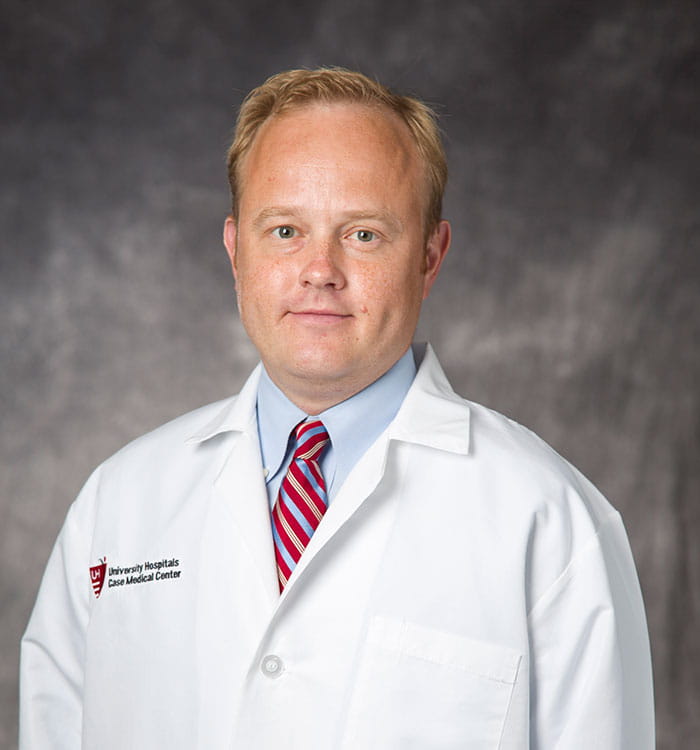High Reliability Medicine Promotes Value for Total Joint Replacement Patients
January 03, 2017
Innovations in Orthopedics - Winter 2017
 Matthew Kraay, MD, MSD
Matthew Kraay, MD, MSD Steven Fitzgerald, MD
Steven Fitzgerald, MD“Everyone’s expectation for total joint replacement surgery needs to be two days or less in the hospital and discharge directly to home.”
These words from Matthew Kraay, MD, MS, Chief, Adult Reconstruction at University Hospitals Cleveland Medical Center and Kingsbury G. Heiple and Fred A. Lennon Chair in Orthopaedics at Case Western Reserve University School of Medicine, would have been thought unlikely or even unsafe a few years ago. Yet, as physician lead for the high-reliability medicine (HRM) initiative for total joint replacement (TJR) at UH, Dr. Kraay has witnessed orthopedic teams across the UH system safely produce just that result.
UH orthopedic surgeon Steven Fitzgerald, MD, Orthopedic Surgery, UH Cleveland Medical Center; Assistant Professor, Orthopaedics, Case Western Reserve University School of Medicine, confirms, “We’ve reduced our hospital stays down to one or two days and significantly decreased the number of people who need to go to a skilled nursing facility after their care. We want people to go home after their surgery. They do better and the risk of infection is lower.”
Dr. Kraay describes the systemwide process as consensus-driven, evidence-based, high-quality and high-value. “It has truly transformed how we provide care for our joint replacement patients across our healthcare system,” he states.
Key principles of the initiative are to improve patient safety, quality, outcomes, patient satisfaction and value while reducing variance in care, waste, inefficiency, complications and readmissions.
“Patients and insurers are increasingly looking for value in healthcare, and our redesign initiative unquestionably promotes value. This is essential as we transition to value-based alternative payment models mandated by the Affordable Care Act,” Dr. Kraay adds.
Staff Buy-In
During a 16-week transformation that began in fall 2015, surgeons, nurses, physical therapists, infectious disease specialists and key operational leaders from 16 UH hospitals analyzed, evaluated and revamped their patient care processes from pre-op through post-op recovery.
The redesign focused on standardizing care to minimize variance, incorporating evidence-based concepts and best practices, and eliminating waste and non-value-added care at each UH facility that performs TJR. Key goals included:
- Manage surgical costs
- Reduce hospital length of stay
- Decrease costly readmissions
- Increase discharge to home versus sending patients to skilled nursing facilities (SNFs) post-surgery
Initiative “champions” at each hospital implemented an educational process and distributed a manual detailing policies and protocols. The elements of the new process were fully put in place in spring 2016.
“With improvements in pain management, accelerated rehab protocols, and the higher level of care that we can provide patients in their homes after hospital discharge, essentially all of our hip and knee replacement patients can go directly home after a short, two-day
hospital stay,” Dr. Kraay says.
“Numerous recent peer-reviewed studies suggest that rehab hospital or SNF stays after joint replacement surgery add limited value to the patients’ care and recovery and are almost never necessary,” he adds.
Practical Applications
“The success of our HRM TJR initiative and all of our future successes in an increasingly value-oriented healthcare environment are dependent on resetting the expectations for our patients, institutions and all providers, and changing the culture of the past,” Dr. Kraay says. “We can’t look at what people did 10 years ago.”
Some notable changes thus far have included:
- Preoperative patient assessment, which has traditionally focused on “medical clearance,” now focuses on addressing modifiable surgical
- risk factors such as obesity, diabetic control (A1C), smoking and substance abuse before surgery. All of these are associated with complications and adverse surgical outcomes.
- The patient’s surgeon is promptly notified about any change in a TJR patient’s status that may put that person at risk of being readmitted. The physician can then provide efficient and appropriate management of medical issues.
- A comprehensive live or Web-based preoperative patient and family education program covering surgery, rehabilitation and recovery is required. Participation is essential in preparing the patient to be released after a two-day hospital stay.
- A care navigator guides patients through preoperative education, preadmission testing, surgery and recovery to ensure that a patient completes all necessary steps.
- Effective postoperative pain management and early rehabilitation get patients out of the hospital and back to their lives more quickly.
Dr. Fitzgerald explains UH’s pain management protocol: “It starts with anesthetic blocks in the OR at the time of surgery. Postoperatively, the biggest thing we do is limit narcotic use. We use a combination of pain medications and anti-inflammatory medications. Reducing narcotics decreases nausea postoperatively and allows us to get people moving faster and out of the hospital earlier.”
Reducing variations in care, improving continuity of care and improving outcomes all have come about through implementation of evidence-based medicine and best practices. Dr. Kraay points out reduced errors and complications and increased patient satisfaction through improved health education and communication.
As Dr. Fitzgerald notes, “It’s all about making patients’ lives better. It’s nice to come out of the OR and round at the end of the day and see your patients walking in the hallway with very little pain. It’s very encouraging.”
Promising Results
“There’s a saying that what doesn’t get measured doesn’t get managed,” Dr. Kraay says. “A key aspect of making high-reliability medicine successful is looking at our data and monitoring our outcomes. We have key performance indicators, and we watch trends and look at where we’re getting better.”
Early results include:
- Length of stay for joint replacement patients decreased by 0.6 days over six months, saving 2,500 hospital days at $500/day.
- The most recent monthly data shows 92 percent of knee replacement patients and 96 percent of hip replacement patients went home versus going to a skilled nursing environment, an improvement of 30 percent over last year.
For more information on this initiative, call 216-844-8372.


